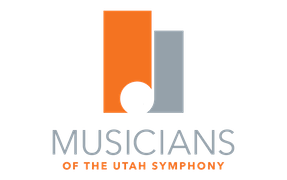More Prague
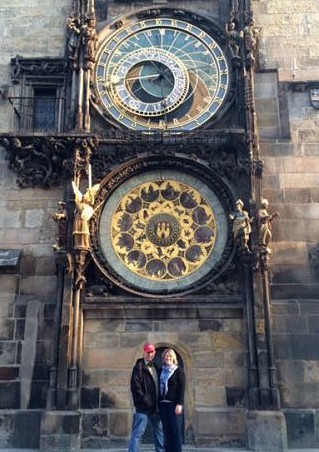
Astronomical clock from 1410
Even without the Moldau River, the beautiful bridges and the imposing palaces in the distance, you might still know you’re in Prague. Firstly, there are a lot of Americans! It is a popular destination for students and the study abroad programs. Older visitors may be attracted to the abundance of fascinating architecture or perhaps the goulash, sausages and pork knuckle. Antique stores, well-fed pigeons, Segways, “change” stores, mimes and vintage automobiles are most everywhere.
Near one of the main squares is an astronomical clock that still runs and attracts attention. Not bad for something built in 1410! One of the common sights are the “Trdelník” (turtleneck) vendors. This tubular pastry treat, cooked on a rotisserie, can be covered with sugar, almonds or chocolate and can be a mess to eat! I still tried. Groups of men, 10 to 15, are also a common sighting. We’re not sure if they are part of a sports team, drinking club or men on the prowl! We nicknamed them “Bro Gangs”. There didn’t seem to be a female equivalent.
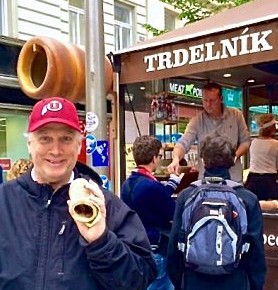
Trdelník treat
In Prague, as in much of Europe, there are no laws on walking etiquette. The streets and sidewalks can be very crowded, and walking on the right is not a universal precept. Consequently, run-ins with strangers are common. A game of “Chicken” can ensue unless YOU get out of the way! It might remind someone of “The Zaks” by Dr. Seuss where the south going Zak meets up with a north going Zak and they both refuse to deviate from their path. While their stubbornness continues, the world builds itself around them. Attempting to avoid an “international incident”, we would most often yield the right-of-way.
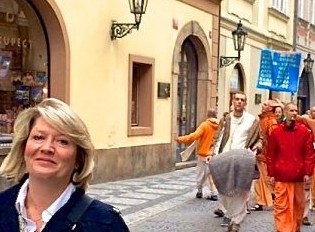
Leading the “Bro-Gang”
We found time to visit the Dvorak and Smetana museums. Besides his years in the United States, Dvorak was a world traveler. “I would give all my symphonies to have invented the steam engine!” he said. He seemed devoted to his family and proud of his Czech heritage. Smetana’s papers were in good supply and, like Mendelssohn, he was a talented artist. Several of his drawings supported that reputation. Our opinion of the importance of the Czech influence on classical music has been elevated when we’ve learned that this area of the world produced composers like Zelenka, Hummel, Mahler, Janacek, Martinu, Smetana, Dvorak and others.
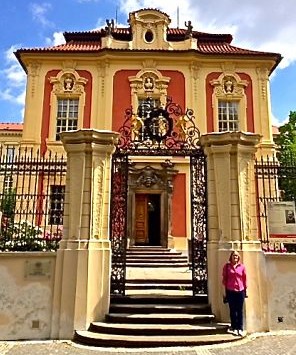
Dvořák Museum
Our second apartment in Prague was near the Charles Bridge, a popular pedestrian walkway over the Moldau River. Artists and musicians line the long bridge competing for the tourist dollar or Euro. Seeing groups of musicians playing together became an everyday occurrence. Maybe a Slavonic dance by Dvorak or a folk song by Janacek? No, it was most often American jazz! Hearing a Czech bassoonist play jazz on the street was fun!
Our concert-going schedule continued with a performance of the Academy of Ancient Music Berlin, one of the premiere baroque ensembles in the world. The ensemble of about 20 musicians were a delight to hear and watch. They mostly stood while they played, including the cello players. Their instruments however rested on the seats of cushioned chairs. One fellow playing a straight contra bassoon got to have a seat. His ten-foot long instrument looked more like a rocket launcher! Fortunately, his “sights” were pointing at the opposing balcony! The conductor was also the concertmaster, and he danced his way through every movement of Lalande, Telemann and Handel, insuring some beautiful ensemble playing. Hearing the baroque oboes was a treat for me.
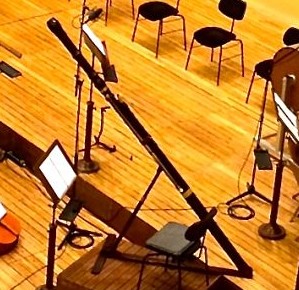
Historical Contrabassoon
The Prague Symphony Orchestra, with Pietari Inkinen conducting, played an interesting program of music by Hanus, Rautavaara and Mahler. The Rautavaara was a movement from his 6th Symphony and had us wishing to hear more. The Mahler was his 5th Symphony. There were various highlights like the Adagietto movement for strings, the horn playing or the bass drum solo in movement 2, but for the most part the performance was rather rough around the edges, with suspect intonation and ensemble.

Smetana Museum
The Czech Philharmonic was definitely a step up in quality. Another “Jiri” (there are 16 musicians in the Czech Phil. with the name Jiri!), Jiri Belohlavek, conducted an exciting Mahler Symphony No. 3. Oddly, for the fourth time in four nights at the Smetana Hall, there was a medical issue which required attention amongst the concert-goers. This time the performance stopped. A woman in the second row fainted. Medical personnel came to the rescue and shortly thereafter, four healthy men lifted the woman off the floor and then rushed her down the center aisle of the hall and out the back doors. Afterwards, Maestro Belohlavek resumed the first movement, giving the audience an opportunity to hear the beautiful trombone solo a second time! The evening featured some terrific brass playing, excellent string work and the gorgeous alto voice of Elisabeth Kulman. The concertmaster solos were also excellent and what seems to be the custom, flowers were awarded to the conductor, soloist and concertmaster at the concert’s conclusion.
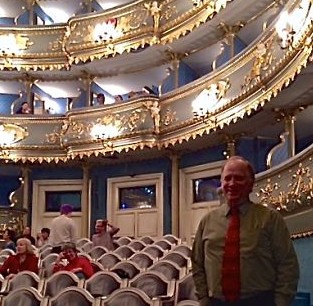
Estates Theatre where Mozart premiered his “Don Giovanni”
I told Lisa I thought it was easier to get lost in Prague than a place like Venice. I shouldn’t have said that! In our only concert debacle (so far) in Europe, we were unable to find the venue for a flute recital up by the Prague Palace. We walked around for more than an hour trying to find this particular hall. Maybe if it had been an oboe recital instead? But what’s a few miles when you’re consuming Trdelníks and chocolate every day!
In the same theater that saw it’s premiere in 1787, we enjoyed Mozart’s “Don Giovanni”. After seeing “The House of the Dead” and “Boris Godunov”, this was indeed a breath of fresh air! The costumes, sets, hairdos and voices were really special. The action included huge masks worn by members of the chorus, dance sequences during the instrumental segments, old black and white film being projected on the back wall, black roses that would suddenly pop up from the floor, a boy dressed like the grown-up Don Giovanni and much more. The small orchestra played very well and balanced the singers at every moment.

St. Nicholas Cathedral
As in Karlovy Vary, we heard a concert of mostly baroque music in a magnificent church, this time featuring voice, organ and the oboe playing of Vojtech Jouza, a member of the Czech Philharmonic. He presented the music of Handel and Marcello and reinforced what I’m oft to say, “I never met a church the oboe didn’t like”! This St. Nicholas Church is a perfect example of baroque art. There are paintings and sculptures on the ceiling, a checkerboard stone floor, an enormous dome and gold everywhere! Mozart performed on the organ there during one of his many visits to the city.
Living next to the busiest bridge in town can be a mixed blessing. A popular sports bar emptied on to our little street and closing time was most often around 3:00am. This would be about the time I’d awaken to hear lively Czech discussions and the sports bar staff dumping beer bottles into the large trash receptacles. The week before, the Americans had beaten the beloved Czech hockey team in the world championship, so it surprised me to hear a group singing “We Are the Champions” by Queen. Maybe one of their countrymen had just won a darts championship! Anyway, Freddie Mercury would have enjoyed the celebration!
Another restaurant recommendation from Lisa’s friend Steven Schultz brought us to “U Fleku”. Imagine going back a few hundred years. The menu is not long but the roasted chicken and beer hall atmosphere was excellent! Thanks, Steven!
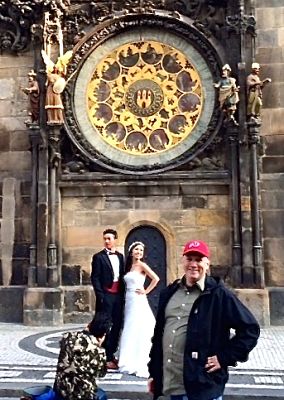
Bridal poses
Another peculiar sighting in different European capitals is young brides and grooms taking pictures of themselves. Sometimes there’s a photographer, but often times not. The bride can be seen wearing her wedding dress and, with today’s technology, selfies are the norm. In Venice I remember seeing many young brides in their wedding dresses just strolling about. Maybe their photo shoot was over!
The Spring Festival has been seen by much of the world through live-streaming, and we were fortunate enough to see one of the popular groups live. The Afflatus Quintet performed in an abbey built in 1230. A large film crew covered most every angle of this excellent woodwind quintet. Their program included works by Reicha, Strauss, Eder, Poulenc and Stravinsky. This group has been together for 20 years and consists of players from various orchestras in Prague. Most memorable was the horn playing of Radek Baborak. He sounded like a 5th woodwind with amazing facility, control and musicality! In the “Till Eulenspiegel” and “Firebird” transcriptions he handled what sounded like 1st, 2nd, 3rd, and 4th horn solos with heroic ease! It’ll be a long-lasting memory! Oboist, Jana Brozkova, used some dynamic phrasing that was especially inspiring.
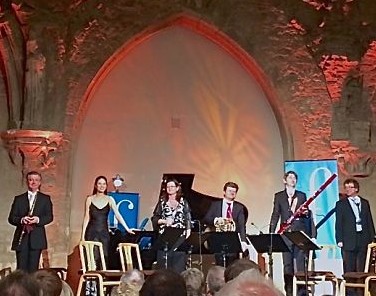
The Afflatus Quintet
It was hard to say goodbye to Prague, but two weeks in Vienna is next. We just might be waltzing before too long!
– Robert Stephenson and Lisa Byrnes
